When considering whether flying at 7 months pregnant is safe, it’s important to acknowledge that every pregnancy is unique, and it’s always best to consult with your healthcare provider before making any decisions regarding travel. That being said, in many cases, air travel during the third trimester can be safe and manageable, with a few precautions and considerations in place.
One important factor to keep in mind is the airline’s policies regarding pregnant passengers. Most airlines have specific guidelines in place for pregnant travelers, typically allowing domestic travel up until around 36 weeks of pregnancy. However, policies can vary between airlines, so it’s crucial to check with your specific airline before booking any flights.
The key to flying safely during pregnancy is to prioritize your comfort and well-being. When flying at 7 months pregnant, it’s essential to stay hydrated throughout the flight, as dehydration can exacerbate common discomforts associated with pregnancy such as swelling and nausea. Bringing along snacks and regularly stretching your legs can also help improve circulation and reduce the risk of blood clots.
Another consideration when flying at 7 months pregnant is the duration of the flight. Shorter flights may be more manageable for pregnant travelers, as extended periods of sitting can be uncomfortable and increase the risk of developing blood clots. If you’re planning a long-haul flight, consider booking an aisle seat for easier access to the restroom and opportunities to stretch your legs.
Medical clearance may also be necessary for pregnant passengers, particularly when flying internationally or close to the due date. Your obstetrician can provide you with a letter confirming your due date and stating that you are fit to travel. This documentation can be invaluable if any issues arise during your journey or when passing through security checks.
While flying at 7 months pregnant can be safe for many women, it’s important to be aware of the potential risks and discomforts associated with air travel during pregnancy. Changes in air pressure can cause ear discomfort, particularly during takeoff and landing, so chewing gum or swallowing can help alleviate this sensation. Additionally, wearing compression socks can help reduce swelling and improve circulation during the flight.
It’s also advisable to pack a small carry-on bag with essential items such as medications, prenatal vitamins, snacks, and any comfort items that may help you feel more at ease during the journey. Having these items readily accessible can make your travel experience more comfortable and enjoyable, reducing stress and potential anxiety.
If you have any concerns or underlying medical conditions, it’s crucial to discuss your travel plans with your healthcare provider to ensure that flying at 7 months pregnant is safe for you and your baby. Your obstetrician can provide personalized advice and recommendations based on your individual health and pregnancy status, guiding you on the best course of action for your specific situation.
Ultimately, the decision to fly at 7 months pregnant is a personal one that should be made in consultation with your healthcare provider. By taking appropriate precautions, listening to your body, and prioritizing your well-being, many pregnant women can safely travel by air during the third trimester. Remember to plan ahead, stay informed, and make self-care a priority throughout your journey to ensure a safe and comfortable travel experience.

